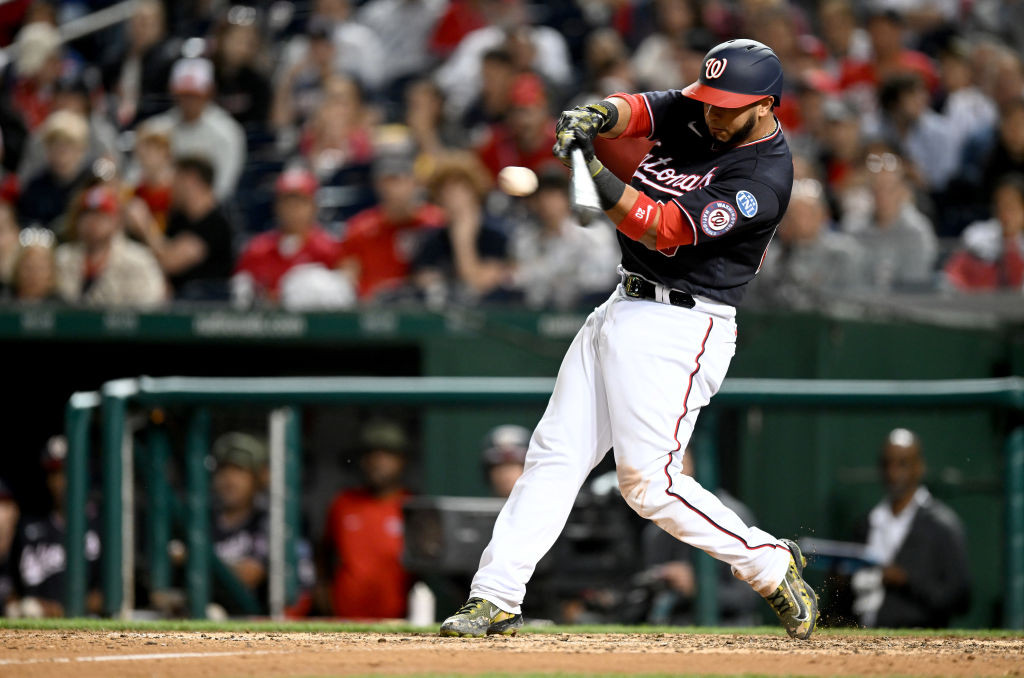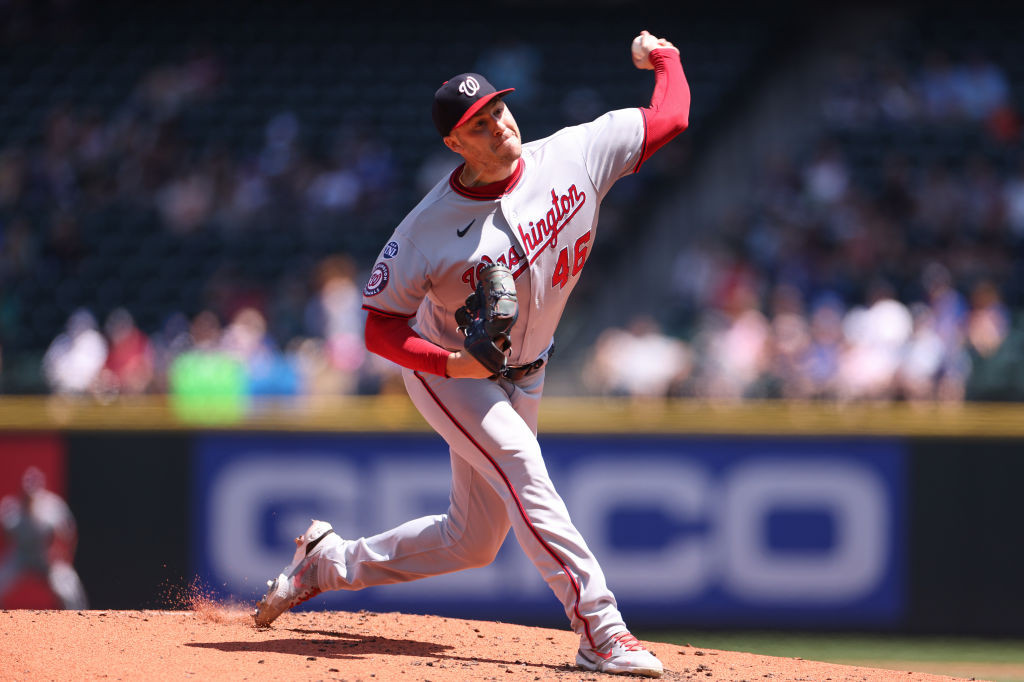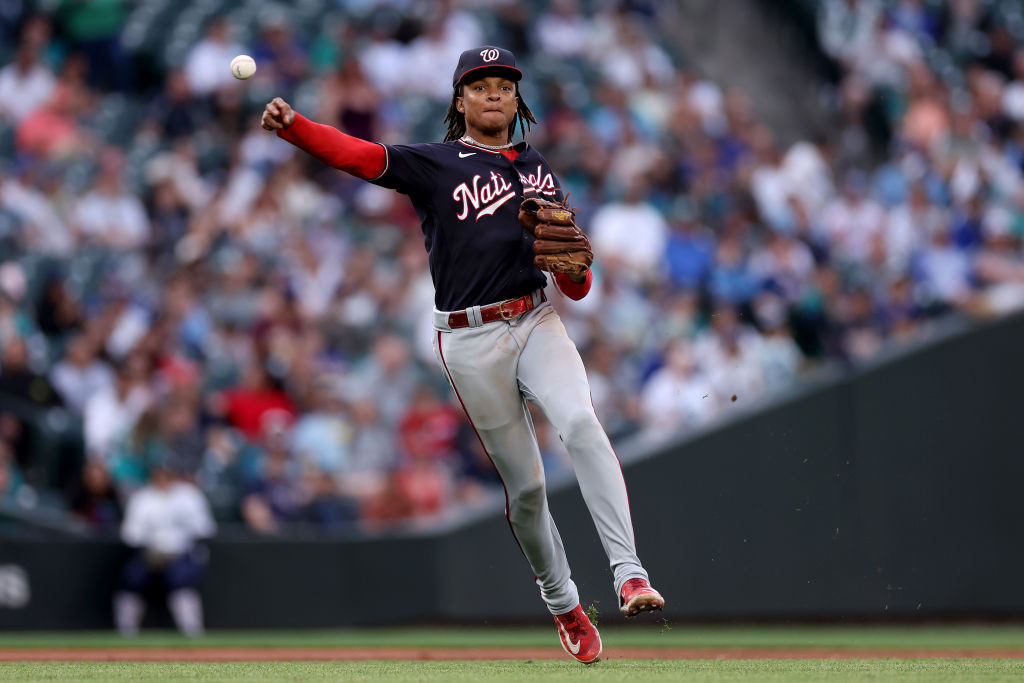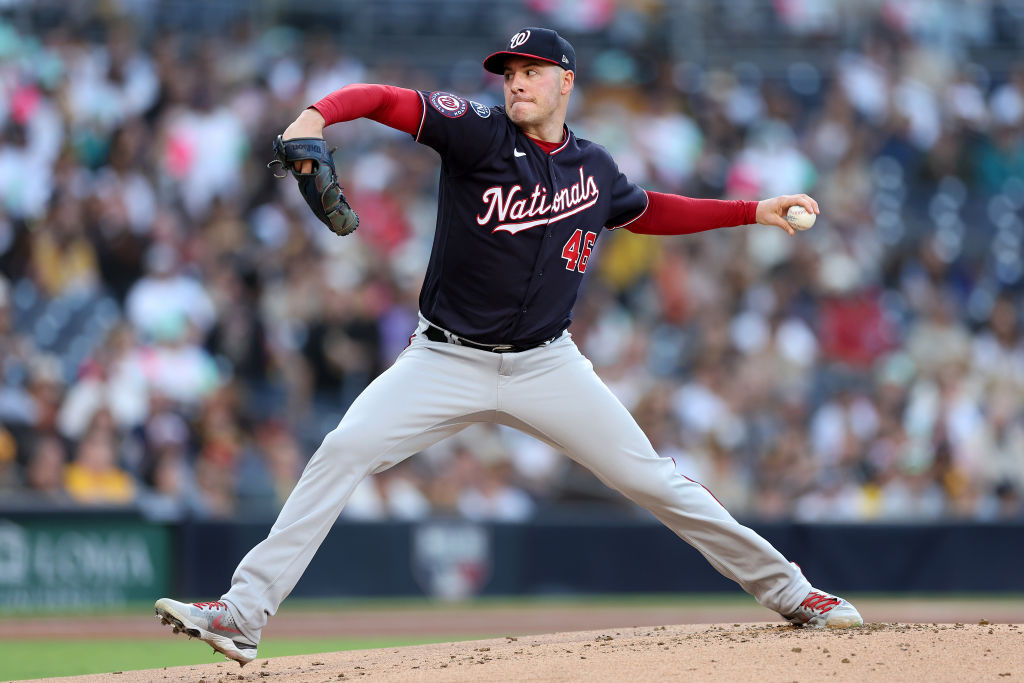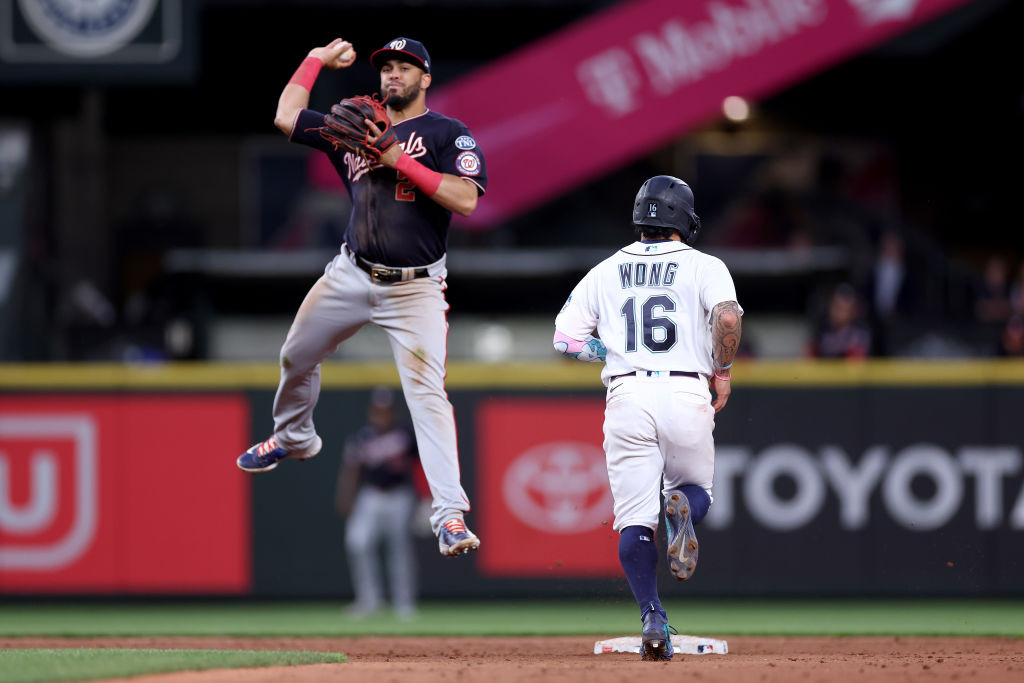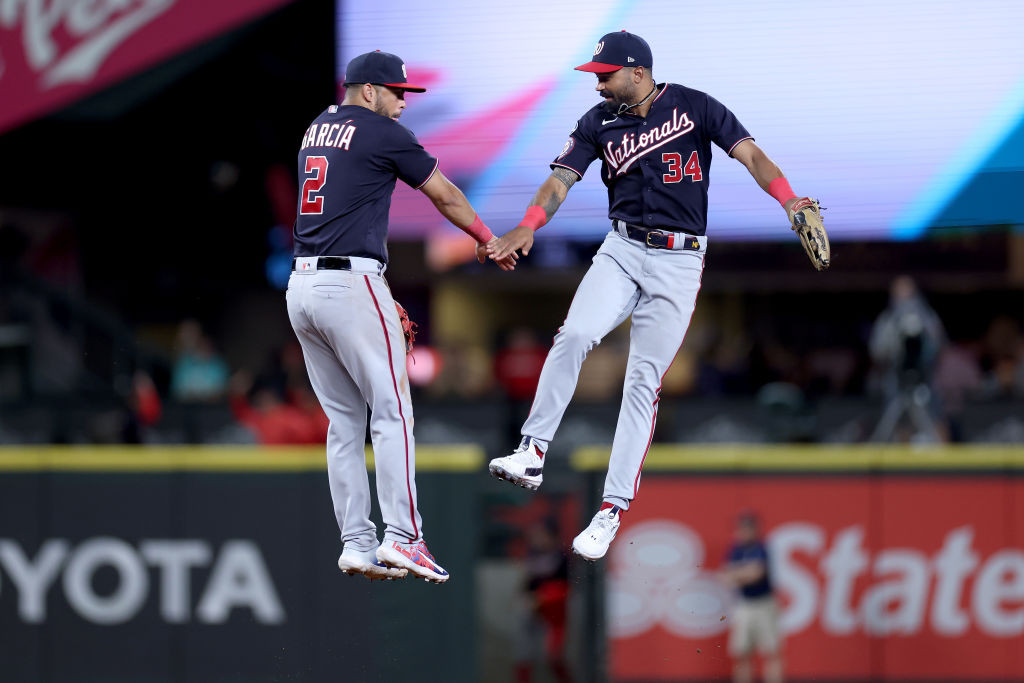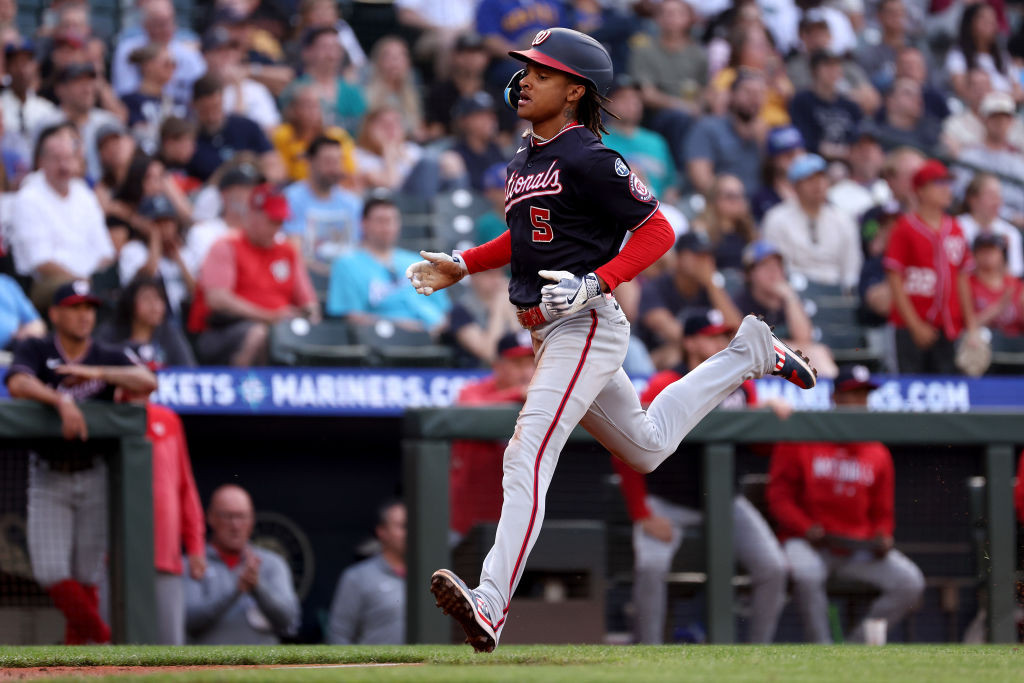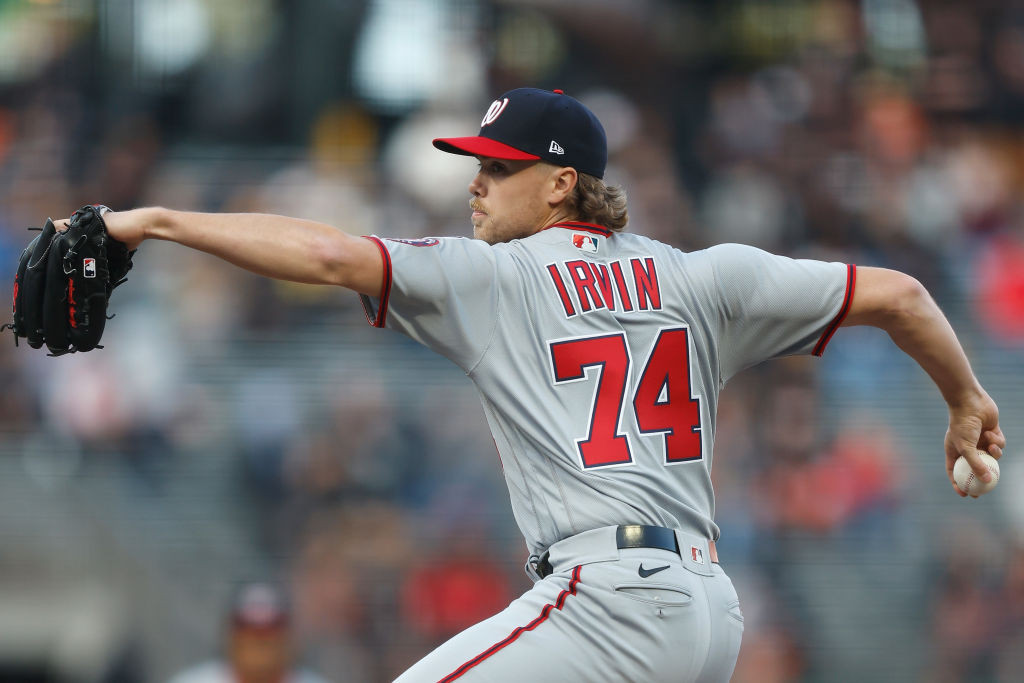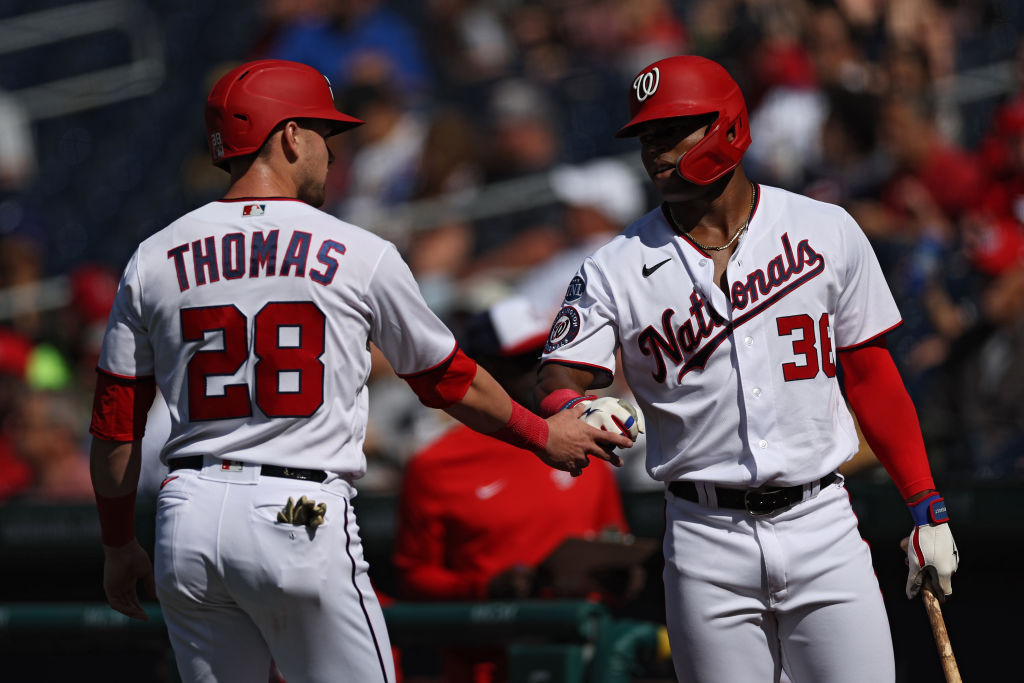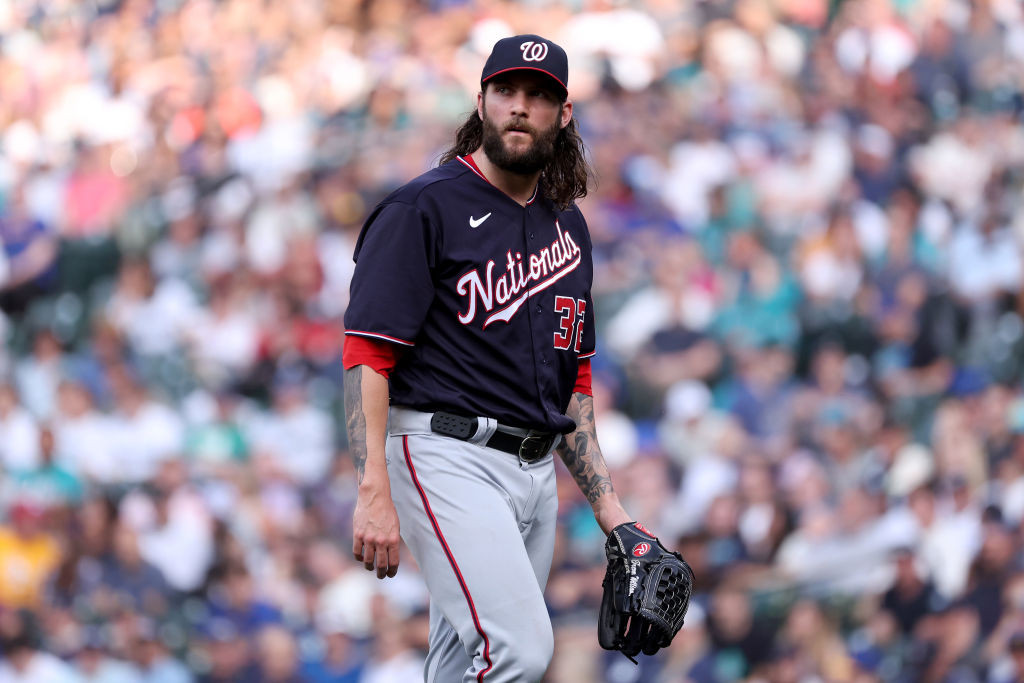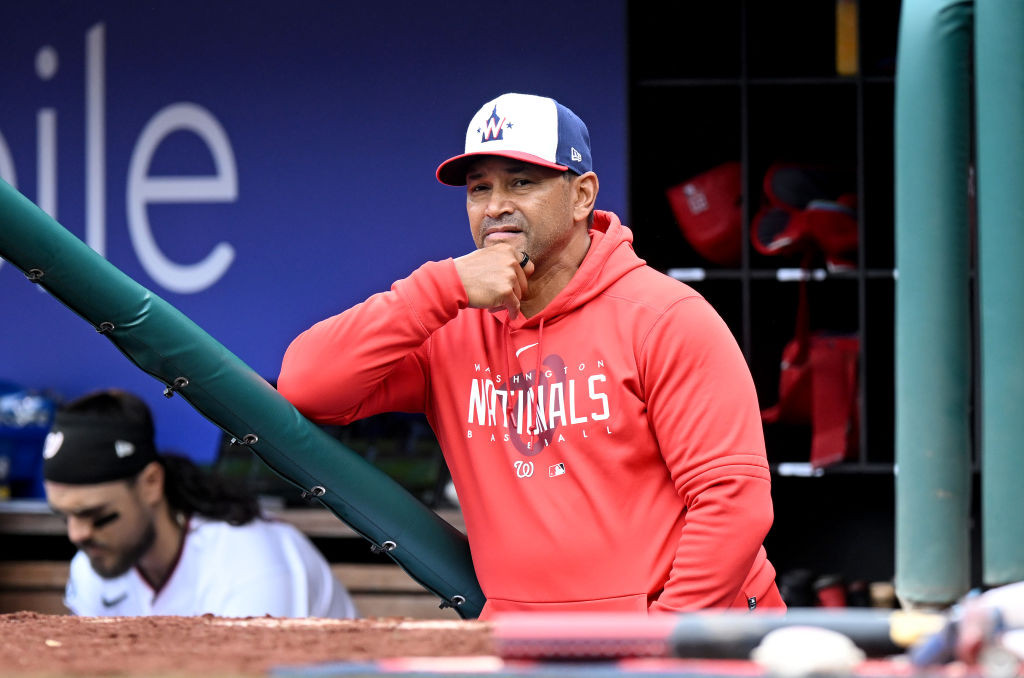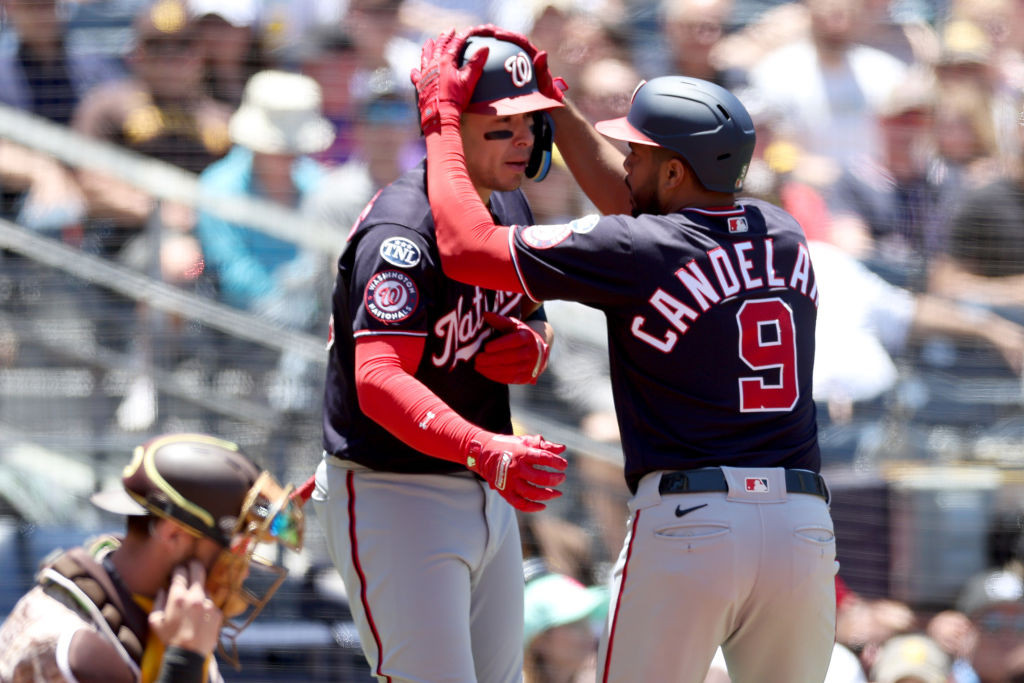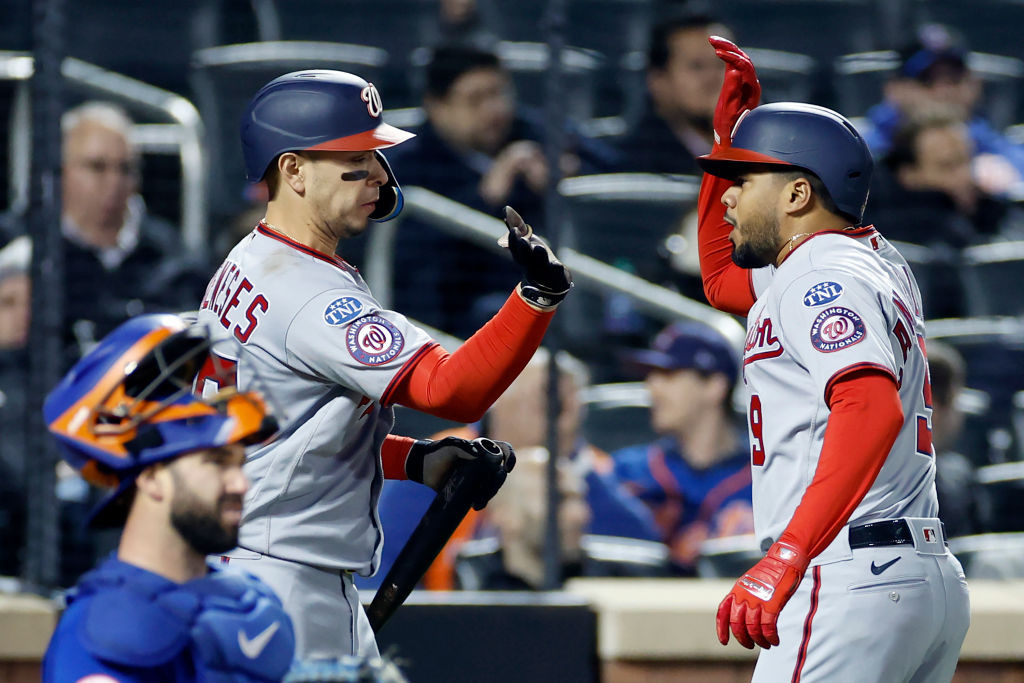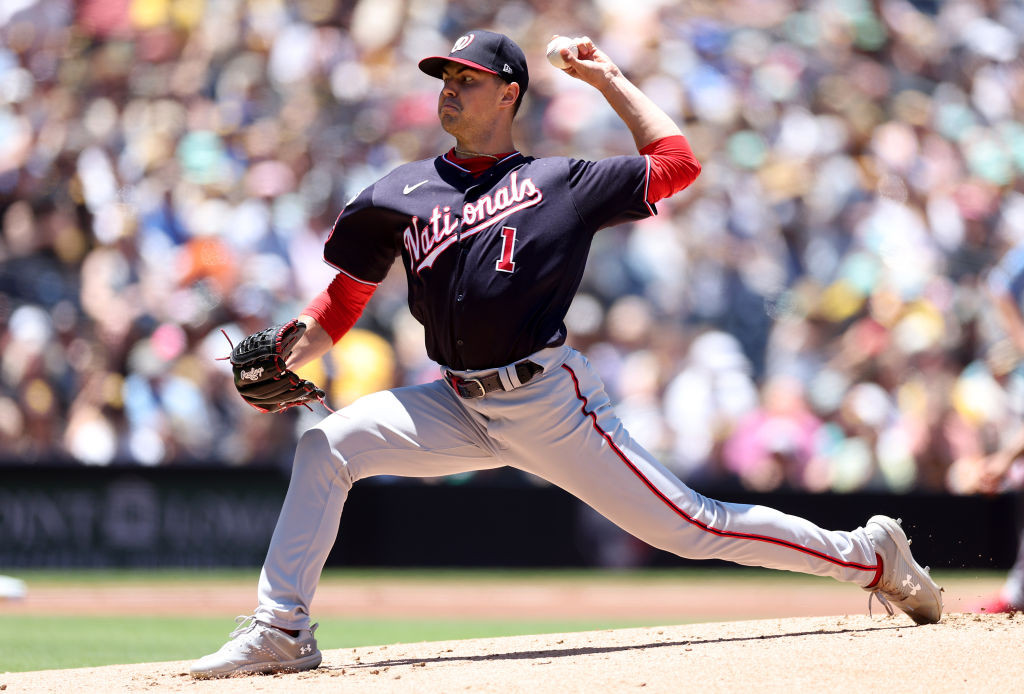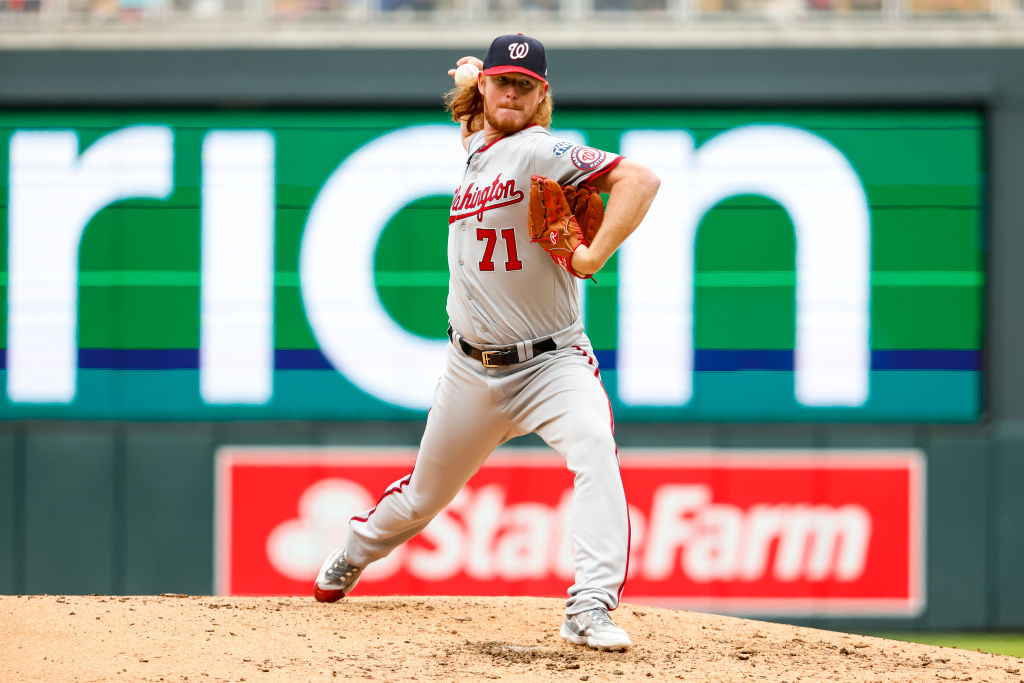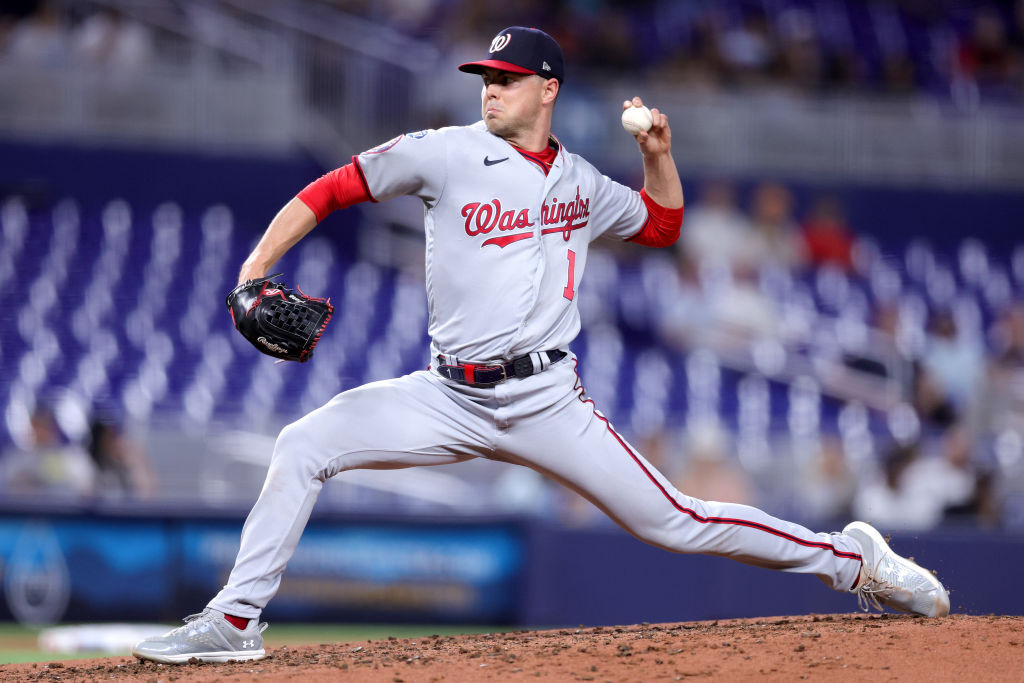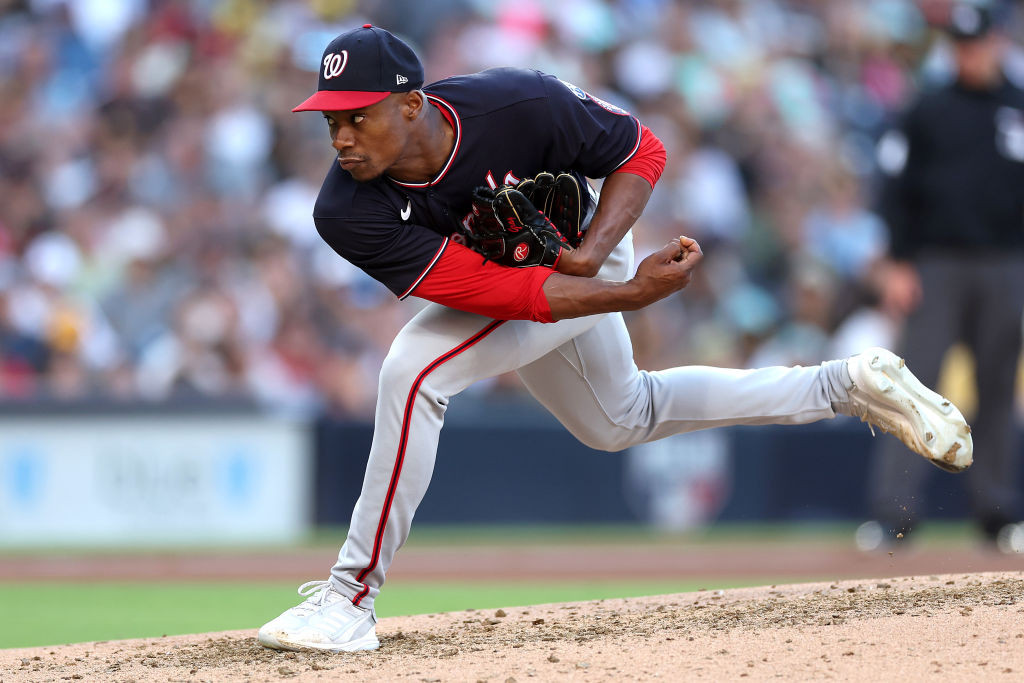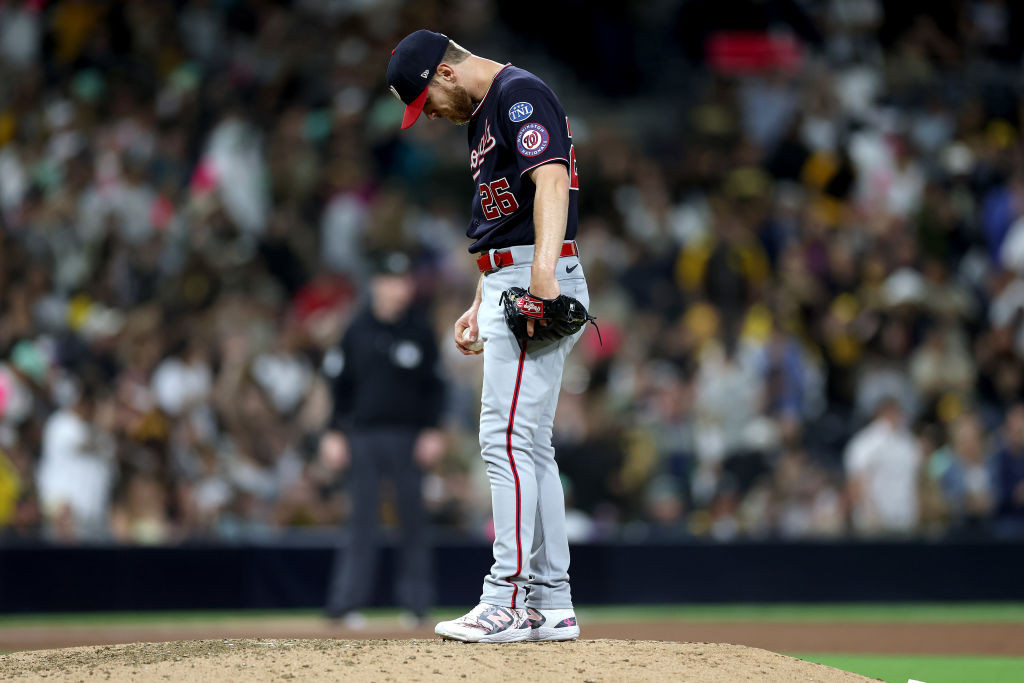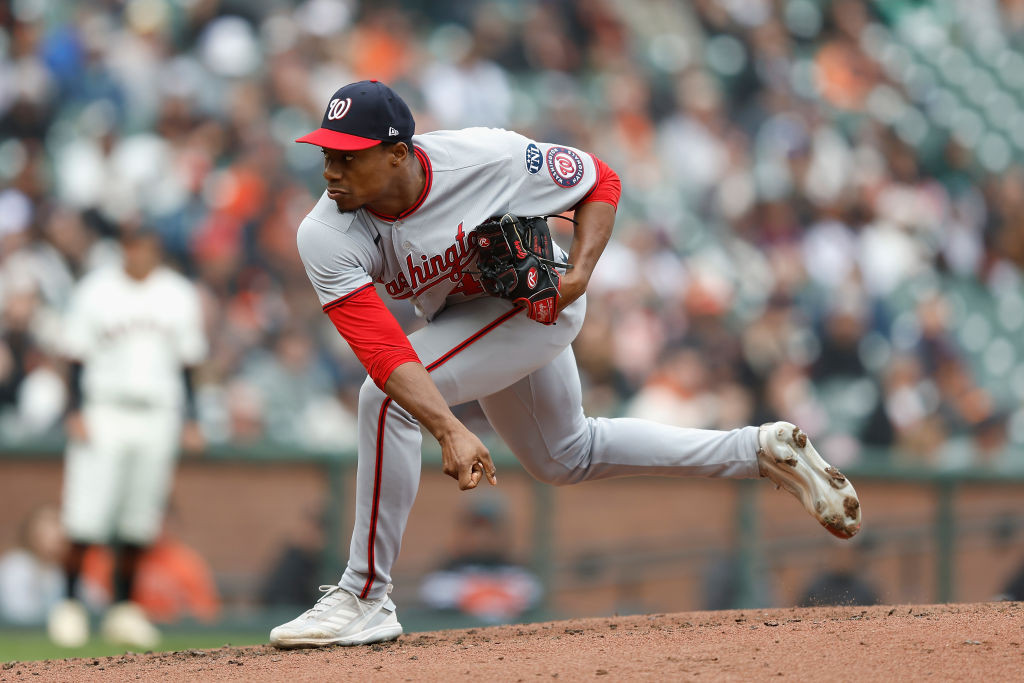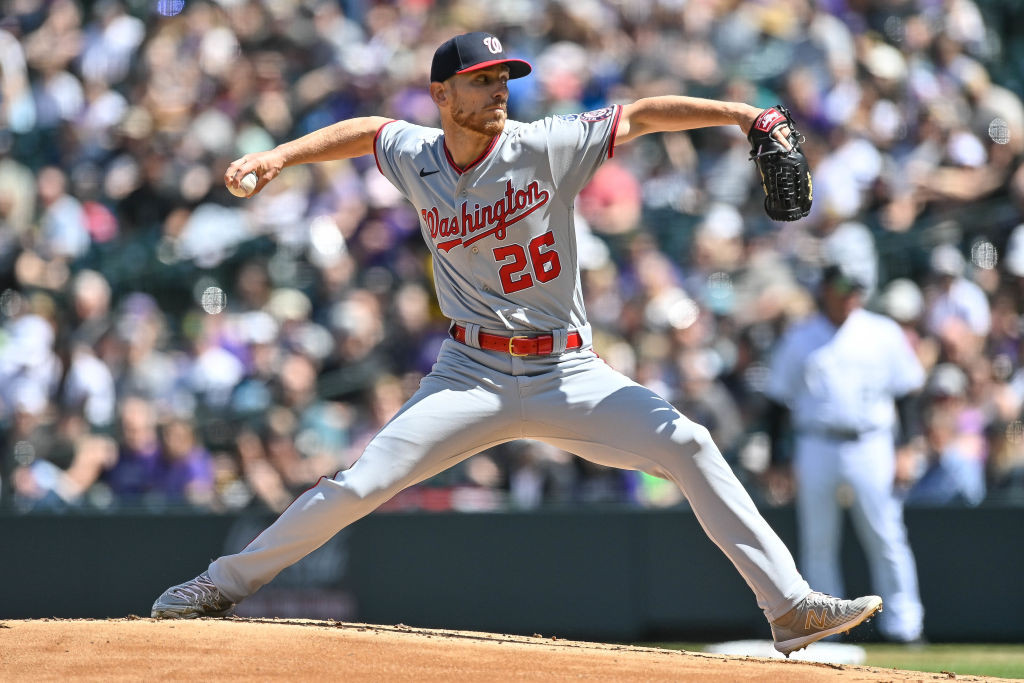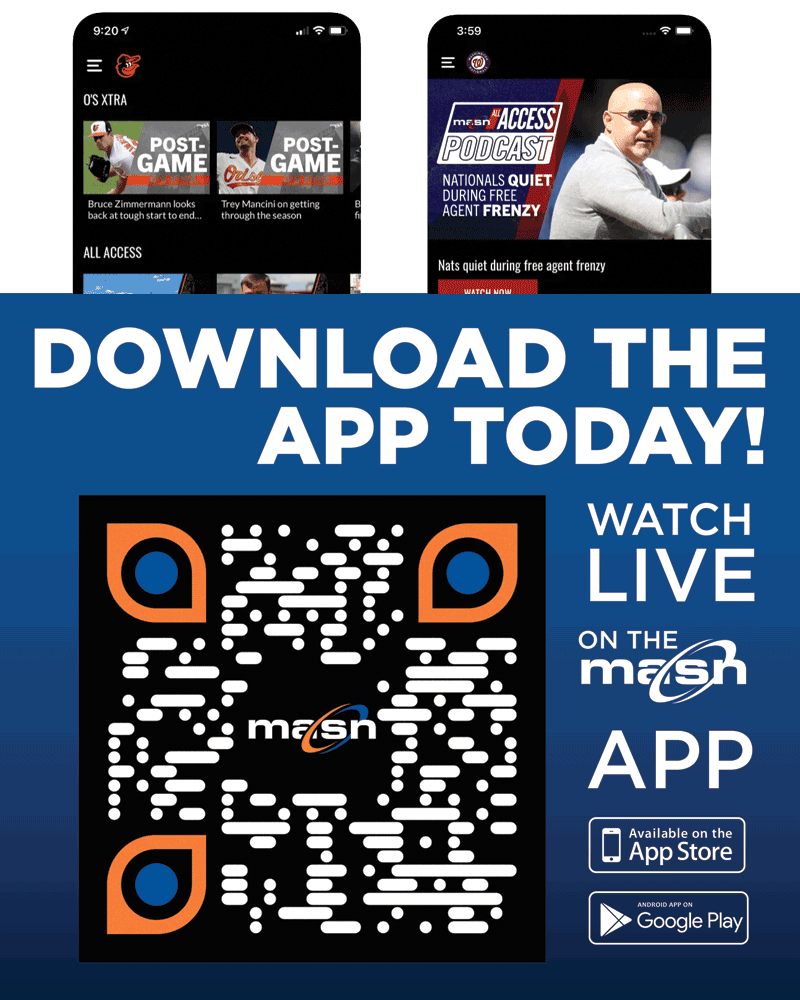SEATTLE – Throughout an often frustrating season at the plate, Nationals coaches have needed to remind Keibert Ruiz that his process has been good, even if the results didn’t suggest it. He was hitting the ball well, just not getting hits.
At some point, though, talk is cheap. Doesn’t a hitter need to actually see positive results to justify the process?
“Yes,” Ruiz said with a wide smile when asked that question Wednesday afternoon. “I need to see a lot of results. Everybody wants to get results.”
Then the Nationals catcher got serious again and finished his answer with the standard company line.
“But I’ve got to control what I can control: Having good at-bats, and that’s it,” he said.
SEATTLE – On another day in which the Nationals were on the wrong end of a baserunning call by an umpire, another day in which Davey Martinez was ejected after arguing the aforementioned baserunning call, victory was still assured thanks to the dominant performance from a source that has been anything but dominant for the better part of 3 1/2 years now: Patrick Corbin.
As his manager and other teammates went ballistic over plate umpire Derek Thomas’ controversial sixth-inning call on Keibert Ruiz for running out of the baseline to avoid a tag at the plate, Corbin stayed above the fray and pitched his best game of the season, leading the Nats to a 4-1 win and a series victory over the Mariners.
"Look, you can say whatever you want about Patrick," Martinez said of his beleaguered veteran lefty. "What I know about Patrick is he's going to take the ball every five days. For me, that's awesome. And I love him for that."
Corbin tossed seven scoreless innings, scattering five singles without issuing a walk. He struck out nine, and needed only 102 pitches to complete those seven zero-filled frames to emerge with his fifth win of the year while lowering his ERA under 5.00 in the process.
"That's the end goal: Get as many wins as we can, and have everybody do their job," Corbin said. "Sometimes, it does get frustrating, but you've got to continue to grind and try to focus on the positives and learn from mistakes. I'm not going to get too high after this one, just look at some of the things I did well and try to improve and get ready for my next one."
SEATTLE – The Nationals wrap up the West Coast portion of their nine-game road trip this afternoon with a matinee against the Mariners. They’ll do so without two regular members of their lineup starting, each for different reasons.
CJ Abrams is sitting after getting hit by a pitch on his right elbow in the top of the seventh Tuesday night. It was actually the second time the young shortstop was hit in that location during this trip, and this time it swelled up enough to warrant departing the game.
Abrams did initially remain in Tuesday’s game and proceeded to steal second after reaching. On the slide, he appeared to get spiked on his right hand. When the inning ended, he remained in the dugout, with Ildemaro Vargas taking over at shortstop for the final five frames of an 11-inning victory.
Abrams was walking around the clubhouse this morning with his right arm in a sleeve after receiving treatment. He didn’t sound concerned about missing any length of time.
“He’s a little sore; he’s getting worked on this morning,” manager Davey Martinez said. “He should be available to pinch-hit, play some defense later on in the game. Just giving him a little breather. He’s a guy who got hit twice in the same spot in a week. He woke up today a little sore.”
SEATTLE – The Nationals have spent an inordinate amount of time on the West Coast this season. Today, they play their 25th road game against West division opponents. Compare that with only six road games against Central teams and only nine road games against East teams. They’ve made four separate trips to California in three months.
The good news: Today is the last time the Nats will play west of St. Louis this season. And they would love to head back east with another win, not to mention a 4-2 record in San Diego and Seattle before departing for Philadelphia.
Davey Martinez’s lineup for the finale against the Mariners does not include CJ Abrams, who was hit by a pitch on the right elbow Tuesday night and had to depart. It does not include Joey Meneses, who gets a rare day off. It does include both Keibert Ruiz (who is DHing) and Riley Adams (who is catching).
Patrick Corbin gets the start, hoping for better results than his blowup start in San Diego to begin this trip (seven runs in five innings). The Nats could certainly use some length from the left-hander today after playing 11 innings Tuesday night.
WASHINGTON NATIONALS at SEATTLE MARINERS
Where: T-Mobile Park
Gametime: 4:10 p.m. EDT
TV: MASN2, MLB.tv
Radio: 106.7 FM, MLB.com
Weather: Sunny, 70 degrees, wind 6 mph out to center field
SEATTLE – Luis García’s RBI single in the top of the 11th was a key moment in the Nationals’ wild, 7-4 victory over the Mariners on Tuesday night. His play at second base throughout the game might have been just as significant, and certainly eye-opening to the team at large.
In what was arguably his best defensive game of the season, García turned two key late double plays. And he nearly turned a third one with an incredibly high degree of difficulty.
With runners on the corners and nobody out in the bottom of the seventh of what was a tie game at the time, Seattle’s Kolten Wong hit a chopper to short. Ildemaro Vargas fielded it and threw the ball to García at second base for the first half of what looked like a routine 6-4-3 double play that would concede the go-ahead run.
But instead of throwing to first, García turned against his body and fired to the plate, where Keibert Ruiz caught the throw and tagged a sliding Jarred Kelenic. Plate umpire Brennan Miller called Kelenic out, and the Nats thought they had just pulled off a rare 6-4-2 double play.
The Mariners, though, challenged the call. And upon replay review, it was determined Kelenic barely slid into the plate before Ruiz could apply the tag.
SEATTLE – The weirdest game of the Nationals’ 2023 season included four pitch clock violations, plus one that was overturned after the umpires huddled up. It included players and coaches from both benches coming onto the field to break up an argument over an accusation Jeimer Candelario was signaling pitch locations while leading off second base.
It included CJ Abrams departing with an injury after getting hit by a pitch on the right elbow. It included several jaw-dropping plays by Luis García, including one that nearly saved the day in the seventh … until umpires overturned their original call upon review and awarded the Mariners the go-ahead run.
It included Keibert Ruiz blasting a game-tying homer in the eighth, the young catcher finally rewarded for the loud contact he’s been making for several weeks. It included a no-doubles defense by the Nats that actually played a ball into a double.
And it ultimately included two desperately needed clutch hits from Lane Thomas and García to propel the Nationals to an exhausting 7-4 11-inning victory.
"They fought," manager Davey Martinez said. "This team is relentless. They don't give up. They stay focused. They stay in the game. And we come out victorious in the end, which was awesome."
SEATTLE – Davey Martinez’s tirade against Doug Eddings last week after the longtime umpire ejected the Nationals manager for arguing balls and strikes generated plenty of video clicks and chuckles from all who watched the replay. Martinez understood that would happen when he got down on his hands and feet and mockingly “caught” a pitch two inches off the ground to show Eddings just how low his strike zone was.
Martinez’s real concern in that moment, and in the days since, though, was how CJ Abrams would respond to it. It was a low strike three call to Abrams that initiated the firestorm in the first place, and Martinez worried his young shortstop would change his approach because of it.
After weeks of work to lay off pitches below his knees, Abrams was starting to show a better eye at the plate. Would that no longer be the case if he was taking those pitches and still striking out due to overeager umpires?
“He’s young, and whenever he gets a call that’s controversial, you see that he tends to expand a little bit more,” Martinez said. “We have to always tell him: ‘Do not let the umpires dictate what you’re trying to do up there. Understand who you are, and understand the pitch you’re looking for. And stay in the zone.’”
The evidence since last week’s incident has actually been encouraging. Abrams has continued to produce good at-bats during this West Coast trip, and he enters tonight’s game against the Mariners batting .393 (11-for-28) with three doubles and a homer over his last eight games.
SEATTLE – Monday night’s series opener was a disappointing one for the Nationals, who squandered an early 3-1 lead against Mariners ace Luis Castillo and wound up losing 8-4, with Jeimer Candelario standing at the plate watching a pitch well out of the zone called strike three with the bases loaded and two outs in the ninth. They can only hope for better results tonight.
The pitching staff should be in better shape tonight, with everyone outside of Cory Abbott available out of the bullpen. That could take some pressure off starter Jake Irvin, though the rookie right-hander will be motivated to follow up his back-to-back strong outings with another one. He allowed just one run a piece to the Marlins and Diamondbacks, completing six innings against Arizona.
Seattle has a rookie right-hander of its own on the mound tonight in Bryan Woo. The 23-year-old, a sixth-round pick in the 2021 Draft, makes his fifth career start. His debut was ragged (six runs in two innings against the Rangers) but he’s been good since (2.30 ERA, 21-to-4 strikeout-to-walk ratio against the Angels, White Sox and Yankees).
WASHINGTON NATIONALS at SEATTLE MARINERS
Where: T-Mobile Park
Gametime: 9:40 p.m. EDT
TV: MASN2, MLB.tv
Radio: 106.7 FM, MLB.com
Weather: Partly cloudy, 73 degrees, wind 5 mph out to center field
NATIONALS
RF Lane Thomas
2B Luis García
3B Jeimer Candelario
DH Joey Meneses
LF Corey Dickerson
C Keibert Ruiz
1B Dominic Smith
SS CJ Abrams
CF Derek Hill
SEATTLE – Lane Thomas made plans a while back to spend his All-Star break at the beach with his wife. He might need to find out if those reservations are refundable, because with each passing day it looks more and more like he’s going to be spending his All-Star break right here in Seattle with the rest of baseball’s best players.
Thomas continues to make a compelling case for himself to represent the Nationals in the All-Star Game, set to be played two weeks from today at T-Mobile Park. What initially looked like a red-hot month at the plate has since turned into a prolonged stretch of success as good as anyone in the sport has produced this season.
With another homer and another RBI double during Monday night’s 8-4 loss to the Mariners, Thomas raised the bar even further. He now has 14 home runs, all of them coming since May 1. He’s now batting .297 with an .860 OPS, and though those numbers may not rank among the league leaders, they’re depressed a bit only because of his slow start to the season.
When Thomas hit his first homer May 1 against the Cubs, he was batting .260 and slugging a paltry .302. He has been nothing short of MVP-like ever since.
In 51 games played since that notable date, Thomas is batting .314 and slugging .614. Extrapolate all of his stats during that stretch over a 162-game season, and his totals would be mind-blowing: 127 runs, 206 hits, 51 doubles, 44 homers, 98 RBIs, 16 steals and a .967 OPS.
SEATTLE – Had they played clean baseball tonight, the Nationals might still have lost to the Mariners. Their lineup might still have gone silent after scoring three early runs off Luis Castillo. Trevor Williams might still have been pulled after four labored innings. Cory Abbott might still have surrendered the go-ahead runs in relief. Jeimer Candelario might still have struck out looking – at a pitch well outside the strike zone, for what that's worth – with the bases loaded and a last-ditch chance to tie the game with one swing in the top of the ninth.
But they certainly weren’t going to win this game playing the unclean brand of baseball they put on display in the opener of a three-game series at T-Mobile Park.
There was a comical error by Dominic Smith, who flipped the ball to first base without realizing nobody was there to catch it. There was a perfect throw by Keibert Ruiz to nab Jarred Kelenic trying to steal second, if not for CJ Abrams not holding the tag long enough. There was an automatic balk called on Williams for disengaging from the pitching rubber three times during the same at-bat.
All of that, along with some ineffective pitching and a lack of offense once the third inning ended, conspired to deal the Nationals an 8-4 loss to Seattle and halt whatever positive momentum they generated during back-to-back wins in San Diego over the weekend.
"Those little things become big things, as we saw," manager Davey Martinez said. "We'll talk about these things again tomorrow. Hopefully, tomorrow we play a cleaner game. Because this game was close for a while there. It was a good game. The boys battled back, but I'd like to see us get through that one inning that kind of beat us."
SEATTLE – A Nationals bullpen that has gone through a number of changes in the last week experienced another one today when the club promoted right-hander Amos Willingham from Triple-A and optioned Paolo Espino back to Rochester.
This move comes only two days after the Nats called Espino up to replace Chad Kuhl, who was designated for assignment. (The club officially requested unconditional release waivers on Kuhl today, making him a free agent.)
Willingham, 24, made a name for himself in the organization early this season, stringing together 10 consecutive scoreless appearances with 14 strikeouts and only one walk for Double-A Harrisburg. That earned him a promotion last month to Triple-A, where he wasn’t as dominant (3.46 ERA, 11 strikeouts, eight walks over 13 innings), but still pitched well enough to earn consideration for another promotion.
“I knew this could be a big year for me,” he said. “I needed to go in and take care of everything I needed to do, and I knew there would be opportunities to move up. I had no idea it would happen this fast. I was thinking at this point in the year maybe get to Triple-A, and then maybe be in Triple-A until September and maybe get a look up here. But it’s all happened so fast, it’s hard to really fathom the entire process.”
The Nationals might have called Willingham up Saturday to take Kuhl’s spot, but he had just thrown 30 pitches over two innings and likely wouldn’t have been available for another couple days. So they instead recalled Espino, who wound up pitching the ninth inning of Sunday’s 8-3 win in San Diego but retired only two of the five batters he faced, prompting manager Davey Martinez to summon closer Hunter Harvey for the final out.
SEATTLE – Hello from the great Pacific Northwest, where the Nationals make only the fourth visit in club history but their second in as many years. They’ve had very good results here, no matter the era, sweeping a three-game set in 2008, taking two of three in 2014 and then splitting a quick two-game series last August. Now they’re back for three with the Mariners, who, like the Padres, had high expectations entering the season but are currently under .500.
Seattle does have a legit ace on the mound tonight in Luis Castillo, who currently ranks sixth in the American League in ERA (2.89), 10th in WHIP (1.053) and seventh in strikeouts (101). The electric right-hander will pose a real test for a Nationals lineup that bust out for nine runs during Sunday’s win in San Diego but as you already know has been in a real rut for quite a while.
Trevor Williams gets the start, looking to build off possibly his best outing of the season, in which he shut out the Cardinals for six innings and earned his fourth win in the process. Davey Martinez let Williams pitch into the seventh in that game, and he may be tempted to push him again tonight because multiple relievers (most notably Hunter Harvey and Mason Thompson) figure to be unavailable tonight after pitching each of the last two days.
The Nats bullpen will have another new face tonight, though: The club called up Amos Willingham from Triple-A Rochester. The 24-year-old right-hander, a 17th round pick in the 2019 draft out of Georgia Tech, has worked his way up the organizational ladder since, and now gets his first promotion to the big leagues. To clear a roster spot for Willingham, the Nationals optioned Paolo Espino back to Triple-A after only one appearance.
WASHINGTON NATIONALS at SEATTLE MARINERS
Where: T-Mobile Park
Gametime: 9:40 p.m. EDT
TV: MASN2, MLB.tv
Radio: 106.7 FM, MLB.com
Weather: Partly cloudy, 72 degrees, wind 5 mph out to right field
SAN DIEGO – Jeimer Candelario ranks among the league leaders in doubles, on pace now for 50 of them by season’s end. Ask the Nationals’ No. 3 hitter about his offensive approach, though, and his answer has less to do with how he gets to second base and more to do with what happens once he’s there.
“Getting in scoring position, for me, is really, really important,” he said. “Because I’ve got a chance to score. That’s how you win ballgames. We’ve got Meneses hitting fourth, and he’s a guy that can put the barrel on the ball. I want to be able to score for him and for the team.”
Candelario knows of what he speaks. Everybody loves to see him hit doubles, but nobody loves it more than the guy who bats behind him and has gone above and beyond to drive him in as well as anyone in the majors.
Joey Meneses’ season totals may not turn heads. He’s batting a healthy .293, but slugging a mere .381. One of baseball’s best (and most surprising) power hitters after he debuted at age 30 last August, he has managed only two home runs through the Nats’ first 77 games this season.
Meneses, though, is doing one thing exceptionally well this year: He’s driving in runs at a remarkable rate when given the opportunity.
SAN DIEGO – As he stalked off the mound, MacKenzie Gore looked directly at Juan Soto, who was looking directly back at the Nationals left-hander. Words were spoken. Heads were nodded. Competitive juices flowed.
There was no disrespect from either party, just an acknowledgment that one had bested the other on this afternoon and that there surely will be future meetings between these two ballplayers forever connected via trade.
"I like him," Gore insisted. "He talks some junk, and he's competitive. I've never played against him much, but I like him."
If future encounters between the two produce the same results as today, the Nats will happily take it.
Gore’s high-energy strikeout of Soto – his third of the afternoon against the former D.C. star – may have come in the fifth inning of what wound up an 8-3 Nationals victory thanks to a parade of late-game hits by the visitors. But it was still the signature moment of a day that included a number of exciting moments but none as important in the long-term picture for this franchise.
SAN DIEGO – If ever there was a time for Mason Thompson to rediscover his early season form, this was it.
With Carl Edwards Jr. on the injured list with a sore shoulder, the Nationals desperately needed someone else to step up and prove worthy of joining Kyle Finnegan and Hunter Harvey in the back of their bullpen, and manager Davey Martinez specifically mentioned Thompson as the best candidate to do that.
So far, so good.
Thompson has tossed nine innings since June 4, all of them scoreless. He’s allowed only four singles and two walks in that time while striking out 10. And his best performance of this run might well have come Saturday night, when he recorded five outs across 1 2/3 innings in relief of Josiah Gray, bridging the gap to Finnegan and Harvey during a 2-0 victory over the Padres.
“It feels great,” the right-hander said. “For me, I always knew that I was one step away. Physically, I felt pretty good out there. I felt like maybe just one little mechanical tweak might get me back on track. Now I’ve kind of got back in that groove. For me, I just need to keep going out there and keep doing the same thing.”
SAN DIEGO – It’s another beautiful day in beautiful San Diego, and nothing would make this weekend any more beautiful for the Nationals than a surprising series win over the Padres. They put themselves in such a position thanks to Saturday night’s 2-0 victory, in which they got two early solo homers and then rode Josiah Gray and their top three relievers the rest of the way.
A duplicate performance might be too much to ask for, but a quality start out of MacKenzie Gore is not too much to ask for. The young lefty has shown plenty of promise this season, but he hasn’t shown consistency. Gore has allowed two or fewer runs in eight of his 15 starts, but he has allowed five or more in two of his last three outings. Emotions will be high today as he faces his former team (against whom he lasted only 4 2/3 innings last month in D.C.). He’ll have to channel those emotions into a better performance today.
The Nationals will try to score more than two runs off Seth Lugo, who gets the start for the Padres. The 33-year-old right-hander is no stranger to the Nats, having faced them for years as a member of the Mets bullpen. He’s now starting in San Diego, where he’s allowed two or fewer runs in three of his last four outings.
WASHINGTON NATIONALS at SAN DIEGO PADRES
Where: Petco Park
Gametime: 4:10 p.m. EDT
TV: MASN2, MLB.tv
Radio: 106.7 FM, MLB.com
Weather: Sunny, 70 degrees, wind 12 mph left field to right field
NATIONALS
RF Lane Thomas
2B Luis García
3B Jeimer Candelario
DH Joey Meneses
LF Corey Dickerson
C Keibert Ruiz
1B Dominic Smith
CF Derek Hill
SS CJ Abrams
SAN DIEGO – How’s this for a formula for success on a lovely Saturday evening at Petco Park: Get two early solo homers from your power-starved lineup, then ask your pitching staff to shut out the Padres’ potent bats the rest of the way?
OK, so that may not have been Davey Martinez’s preferred plan entering the day. Given his team's major league worst minus-44 home run differential entering the day, why would it have been? But as this game proceeded, it became clear this would be the only way the Nationals were going to emerge victorious.
And when they pulled it off, topping the Padres 2-0 behind some of the best pitching they’ve seen all year, it felt as sweet as any of their previous 28 victories this season.
"That," Martinez said, "was a good one."
Jeimer Candelario and Lane Thomas provided the early offense, with Candelario homering in the first and Thomas homering in the third to give their team the lead. Josiah Gray turned in 5 1/3 scoreless, if not exactly efficient, innings to maintain that two-run lead. And then Martinez entrusted the game’s final 11 outs to the three remaining healthy relievers he trusts in high-leverage spots: Mason Thompson, Kyle Finnegan and Hunter Harvey.
SAN DIEGO – The Nationals parted ways with Chad Kuhl today, designating the struggling right-hander for assignment and recalling Paolo Espino from Triple-A Rochester to take his roster spot.
The club had been hoping Kuhl might turn things around as a long man in their bullpen, but the 30-year-old was in a sustained rut, his ERA climbing to 8.45 following a four-run appearance during Friday night’s blowout loss to the Padres.
The move was particularly tough for manager Davey Martinez on a personal level, given how much the Nationals have done to help Kuhl’s wife, Amanda, who is currently undergoing chemotherapy for breast cancer. The Kuhls established the “Cancer Isn’t Kuhl” campaign in April in partnership with Washington Nationals Philanthropies and have raised tens of thousands of dollars for breast cancer treatment and research since.
“The toughest part of my job is letting guys go when you start building these relationships with them,” Martinez said. “It’s hard. I know he gave it his all. It just didn’t work out.”
Initially signed to a minor league contract in January, Kuhl came to big league camp this spring and earned a spot in the Opening Day rotation after top prospect Cade Cavalli needed Tommy John surgery. A six-year major league veteran with the Pirates and Rockies, he struggled from the get-go and had a 9.41 ERA in five starts before landing on the 15-day injured list with a foot ailment.
SAN DIEGO – The Nationals’ lineup is in a bad place right now. That group has averaged 3.3 runs, 8.6 hits and a measly 1.2 walks over the last 18 games, only three of which the team has won. So what’s the cure for an anemic offense? Maybe a rookie knuckleballer making his major league debut?
That’s the unusual situation the Nats find themselves in tonight, with the Padres giving the ball to right-hander Matt Waldron and hoping for the best. The 26-year-old (who throws a knuckleball about 50 percent of the time) was just 1-6 with a 7.02 ERA and 1.650 WHIP in 14 games at hitter-friendly Triple-A El Paso, but with Michael Wacha dealing with shoulder trouble, San Diego is giving him a chance to see what he can do in the big leagues for the first time. This feels like a game that is either going to go wonderfully or horribly for the Nationals, nothing in between.
Josiah Gray’s task tonight is keep the Padres lineup in the yard, something Patrick Corbin and the bullpen couldn’t do Friday. After showing significant progress in this department in April and May, Gray has fallen back into his old pattern from last season, serving up six homers in his last four starts, including two in five innings Monday against the Cardinals.
Speaking of the Nationals bullpen, there has been a roster change. Chad Kuhl was designated for assignment following another rough performance Friday night, and Paolo Espino has been recalled from Triple-A Rochester to take over as a long man in a bullpen that needs more reliable arms.
WASHINGTON NATIONALS at SAN DIEGO PADRES
Where: Petco Park
Gametime: 8:40 p.m. EDT
TV: MASN2, MLB.tv
Radio: 106.7 FM, MLB.com
Weather: Clear, 67 degrees, wind 11 mph left field to right field
SAN DIEGO – Very little went right for the Nationals on Friday night. Such is the case when you lose a game like they did, 13-3 to the Padres.
The focus of the game story was Patrick Corbin, whose fifth-inning meltdown turned a competitive game into a blowout. But the left-hander was far from the only reason the Nats were shellacked by San Diego.
The lineup once again did very little for most of the night. Through five innings, they managed three hits and failed to score a run. They did finally get to Joe Musgrove in the sixth on a two-out double by Jeimer Candelario and an RBI single by Joey Meneses. And then they scored two more runs in garbage time in the top of the ninth.
But most telling was Musgrove’s final line: seven innings, six hits, one run, zero walks, seven strikeouts, 90 pitches, 67 strikes.
The Nationals once again drew zero walks, a recurring problem that seems to be getting worse by the day. They’ve drawn a grand total of 22 walks over their last 18 games, barely more than one per game. They haven’t drawn more than two walks in a game since June 13 in Houston. They haven’t drawn more than three walks in a game since May 28 in Kansas City.

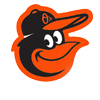
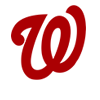

-1745819772711.png)
